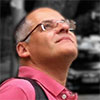ARCHIVE PROGRAMME 2015
MONDAY 29 JUNE 2015
| CONFERENCE DAY 1 | ||
| 08:00 Registration | ||
| 09:00 Opening of MIDI 2015 | ||
| 09:00-10:00 | David Lamas, Tallinn University, (Estonia) |
Keynote talk: Ubiquitous Computing, Distributed User Interfaces, and Design Patterns: Tackling the Challenge of Designing for Ubiquitous Interactions Abstract |
| 10:00-10:30 Coffee break | ||
| SESSION 1 - METHODS AND CONCEPTS | ||
| 10:30-11:00 | M. Mottus and D. Lamas | Aesthetics of Interaction Design: A Literature Review |
| 11:00-11:30 | A. Vosylius and K. Lapin | Usability of Educational Websites for Tablet Computers |
| 11:30-12:00 | A. Bobkowska | Balance between Creativity and Methodology in Software Projects |
| 12:00-12:30 | G. de Haan | Educating Creative Technology for the Internet of Things - Research and Practice-oriented Approaches Compared |
| 12:30-13:00 | A. Landowska | Towards Emotion Acquisition in IT Usability Evaluation Context |
| 13:00-14:00 Lunch break + coffee | ||
| SESSION 2 - ENGINEERING INNOVATIONS IN DEVELOPING INTERACTIVE PRODUCTS | ||
| 14:00-14:30 | A. Bier and Z. Sroczynski | Adaptive Math-To-Speech Interface |
| 14:30-15:00 | J. Balata, Z. Mikovec and L. Neoproud | BlindCamera: Central and Golden-ratio Composition for Blind Photographers |
| 15:00-15:30 | G. Epelde, A. Murua, E. Carrasco, B. Pecharroman, A. Martinez, B. Gomez, J. M. Susperregui and A. Aguirre | Enriching Web-services to Facilitate the Creation of User-tailored User Interfaces |
| 15:30-16:00 | M. Kuhn | Applying Patterns when Generating Code: a Model-based Design Approach |
| 16:00-16:30 | M. Wichrowski, D. Korzinek and Krzysztof Szklanny | Google Glass Development in Practice: UX Design Sprint Workshops |
| 18:00 Social event - trip and party Restaurant Kompania Piwna, ul. Podwale 25 |
||
KEYNOTE SPEAKER
David Lamas, Tallinn University, Estonia

Profile:
David Lamas is Professor of Interaction Design as well as the Head of the Interaction Design Lab at Tallinn University. David is also the Head of the Master's Programme on Human-Computer Interaction at the same university. His research focuses on Theory Informed Interaction Design and he is passionate about it.
Keynote talk:
Ubiquitous Computing, Distributed User Interfaces, and Design Patterns: Tackling the challenge of designing for Ubiquitous Interactions
Abstract:
As Mark Weiser's vision for ubiquitous computing is being realised, interaction design must tackle the challenge of designing computer interfaces:
- distributed across multiple devices, multiple users, and multiple platforms;
- in the same space or in different geographical spaces;
- at the same time or at different points in time.
Designing for these distributed user interfaces requires dealing with emerging key aspects of interaction design such as parallelism and distribution, among others. Design patterns, initially proposed by Christopher Alexander as a way of documenting solutions for specific design challenges have been used in the past to support interaction design challenges. In his talk, David draws on previous work on ubiquitous computing, distributed interfaces and design patterns to introduce ongoing work on the definition of a pattern language for ubiquitous interactions.
TUESDAY 30 JUNE 2015
| CONFERENCE DAY 2 | ||
| 09:00-10:00 | Bartosz Broda, Samsung Polska | Keynote talk: The Role of Natural Language Processing in User Interfaces Abstract |
| 10:00-10:30 Coffee break | ||
| SESSION 3 - USER-BASED STUDIES | ||
| 10:30-11:00 | H-L. Pender, D. Lamas and A. P. Costa | Designing for Meaning Making in Museums |
| 11:00-11:30 | P. Chynał and J. Sobecki | Statistical Verification of Remote Usability Testing Method |
| 11:30-12:00 | H. Dudycz | Usability of Business Information Semantic Network Search Visualization |
| 12:00-12:30 | R. Hetherington | The Believability of Hyper Realistic Characters in Animated Movies |
| 12:30-13:00 | W. Szwoch | Emotion Recognition Using Physiological Signals |
| 13:00-14:00 Lunch break + coffee | ||
| SESSION 4 - INNOVATIONS, SERVICES, CREATIVITY, EDUCATION | ||
| 14:00-14:30 | J. Kwiatkowska, O. Górnicka, W. Bartkowski and D. Lamas | Applying Generative Techniques to Avoid Technology Push Effect in Ideas and Prototypes Created by Technology-oriented People |
| 14:30-15:00 | I. Soute, D. Tetteroo, K. Schelle, J. Gubenko, R. Kreymer and C. G. Naranjo | Increasing Engagement in Workshops: Designing a Toolkit using Lean Design Thinking |
| 15:00-15:30 | M. Szwoch | Design Elements of Affect Aware Video Games |
| 15:30-16:00 | S. Ostrowski, R. Rolczyński, J. Pniewska and I. Garnik | User-friendly e-Learning Platform: a Case Study of a Design Thinking Approach |
| Closing and summary | ||
| 16:30 Interactive lab & demos - Farewell drink and snack Room no. 234 |
||
KEYNOTE SPEAKER
Bartosz Broda, Samsung Polska

Profile:
Bartosz Broda finished his PhD in Natural Language Processing (NLP) at Wrocław University of Technology. During his research work at the university he tackled many NLP problems, with the main emphasis on large scale statistical methods. Among others, he contributed to development of Polish wordnet (plWordNet), feasibility prototype of Polish CLARIN centre and Jasnopis.pl. Currently he works on text readability in cooperation with University of Social Sciences and Humanities (SWPS) and Institute of Computer Science, Polish Academy of Sciences. Bartosz is also leading advanced research NLP projects in Samsung R&D Institute Poland. He deepened his understanding of psychological aspects of human language during his postgraduate coaching studies at SWPS. Additionally, he is a coach in his company called BB Coaching.
Keynote talk:
The Role of Natural Language Processing in User Interfaces
Abstract:
The main role of user interface is to facilitate communication between humans and machines. Contemporary applications present new challenges for user interface (UI) designers. Computer programs took a long way from offline desktop use cases to web, mobile, smart TV and smartwatch environments. This environment diversity and great variety of new constrains create new challenges for UI designers. The emerging concept of the Internet of Things raises the complexity even further. Moreover, today we live in permanent information overload, which should be taken into account while designing the user experience.
In his talk, Bartosz will draw on his experience in Natural Language Processing to discuss aspects of interface design that can be approached via interaction based on natural language. He will focus on the role of speech and handwriting recognition and their use in modern user interfaces. He will also address often overlooked aspect of content-rich applications (for example, web applications): readability of text communicated to the user.


























